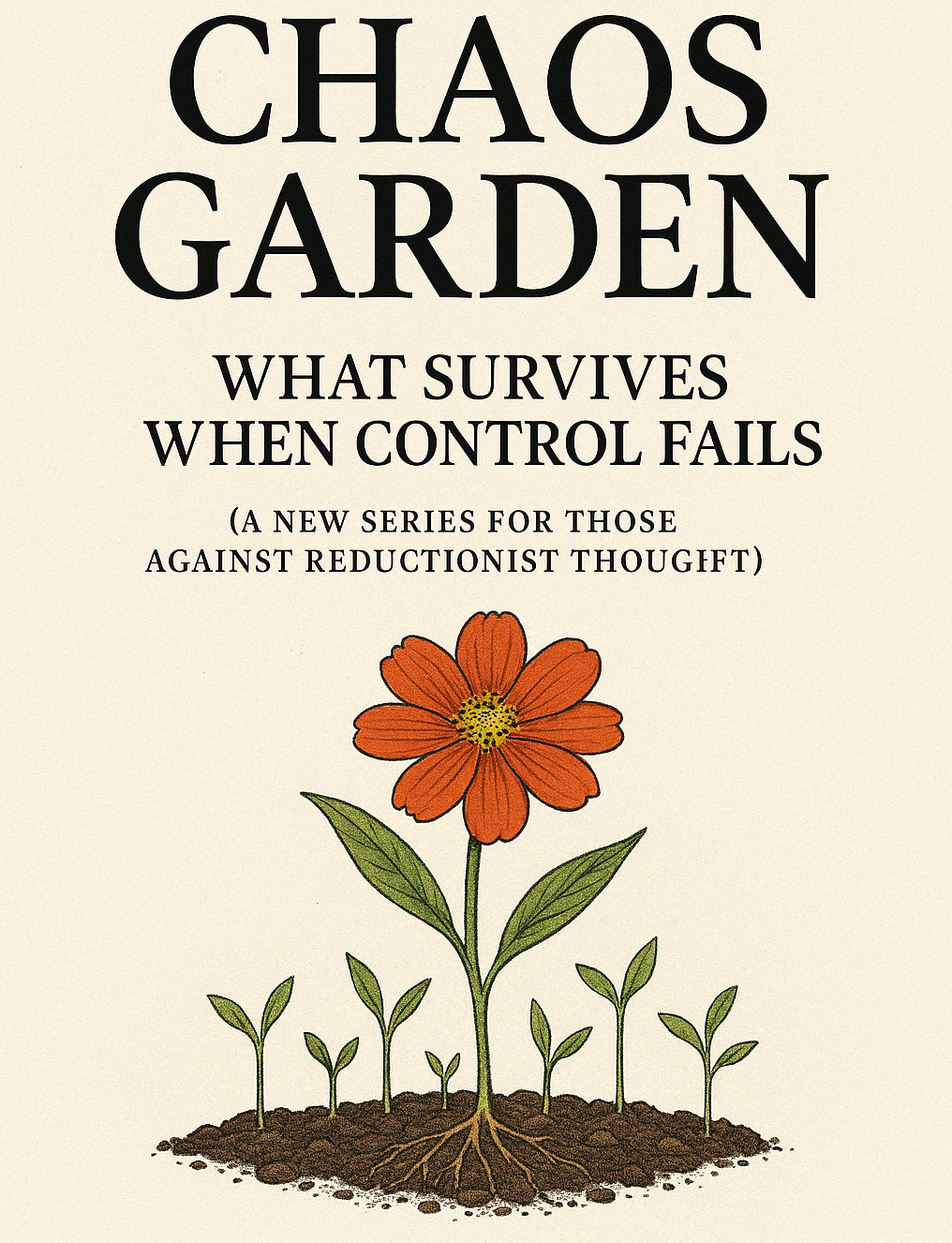Chaos Garden: What Survives When Control Fails
A New Series for Those Against Reductionist Thought
This series began with a conversation. Three hours long. Unscripted. Unpruned.
Robin, my dear friend in New York, a professional in everything flowers, was telling me about her latest obsession: a chaos garden. She was giddy. Not performatively. Structurally. The kind of joy that comes from watching disorder bloom into something that refuses to be ornamental.
When I asked what a chaos garden was, she explained: you take all your leftover seeds: wildflowers, cut-flower favorites, native stragglers, and scatter them. No rows. No spacing. No choreography. Just soil, sunlight, and surrender. You set the stage. What grows is what metabolizes contradiction. What survives is what refuses control.
We talked about it for hours. About how chaos gardens are metaphors for everything human. The Big Bang. Democracy. Sport. Business. Grief. Governance. Language. Succession. Coalitions. Creative voice. All of it. Systems that thrive not because they’re optimized, but because they’re breachable, unfinished, and narratively alive. A perfectly democratize ecosystem where plants rise and fall on capability and a little bit of luck. Where merit topples protectionism and bias.
That conversation became this series.
Chaos Garden is a serialized breach map.
A five-part essay arc threaded across each of my Substack sectors. It’s not a metaphor for disorder. It’s a design logic for survival. Each installment carries a motif that mutates under pressure. Misrecognition becomes emotional imperfection. Fidelity becomes ecological tension. Defiance becomes redesign.
The series will publish every Thursday beginning September 5
Each Thursday, a new installment will drop, strategically threaded across one of the five sectors:
Installment I: The Weeds We Subsidize, What Grows When Neglect Is Legislated| Sector: Policy Without Apology
Installment II: Syntax in the Soil Chaos Garden: What blooms when grammar refuses containment| Sector: Unsentimental Letters
Installment III: Seeds Without Permission, The Succession That Refused Pruning| Sector: Boardroom Mechanics
Installment IV: A Parasite Dressed in Pollinator Clothes, Pollinator, Parasites and the Olympic Movement| Sector: Profit & Play
Installment V: The Bloom Penalty | Section: Working Under the Unqualified
And because this space is built for more than serialized architecture, I’ll continue publishing standalone pieces every Monday: essays, critiques, and tactical reflections independent of the Chaos Garden arc. Mondays are for the unexpected. Thursdays are for the thread.
Here’s what’s coming:
The Weeds We Subsidize
On the administration’s $10B investment in Intel—and what happens when dysfunction is legislated as innovation.
Spoiler: the republic didn’t need another semiconductor. It needed governance.Syntax in the Soil
On language as compost. Essays that refuse ornamental polish and metabolize emotions into grammar.
Spoiler: clarity isn’t clean. It’s fermented.Seeds Without Permission
On mentorship as propagation. Succession kits that survive the architect and refuse institutional sunlight.
Spoiler: restraint isn’t evasion. It’s redesign.Pollinators & Parasites
On coalitions as ecosystems. Sparring as fertilization. Mimicry as parasitism.
Spoiler: not every ally is a pollinator.Bloom Logic
On creative voice as serialized wildness. Essays as breach maps. Narrative fidelity as survival.
Spoiler: pruning is punishment. Improvisation is architecture.
In Case you’re wondering how to go about reading Chaos Garden, you’re not here to agree. You’re here to distill.
This series isn’t optimized for clarity. It’s built to survive contradiction. Each Thursday, a new breach map drops, threaded through one of five sectors. Each Monday, something unexpected arrives: essays, critiques, reflections that refuse serialization. You’ll read:
Essays that compost emotion into structure
Language that ferments under pressure
Systems that bloom without permission
You’ll notice patterns. Motifs that mutate. Questions that don’t resolve. Some pieces will feel unfinished. That’s intentional.
There’s no right way to read this. But if you’ve ever been misread by a boardroom, punished for emotional realism, or asked to flatten your fidelity into compliance, this garden might feel familiar.
This series isn’t built for applause. It’s built for redesign. Each piece will carry a reader prompt, a breach simulation, and a fidelity tag.
Let’s see what blooms!
Like what you see here?
Consider subscribing, pledging, or buying me a cup of coffee, whatever keeps the signal alive and the nonsense metabolized.






https://m.youtube.com/watch?v=njxjgVxqRLc
🌹💐🌺🌷🥀🌼🪻🪷
I know you’re not speaking literally about chaos gardens but I’m obsessed with the natural world and my attempts to foster a refuge in the city. I can’t remember where I read it, but years ago an anthropologist had a paper about personality, politics and landscape. A friend swore he could drive down the street, look at a lawn and garden, and tell how the occupants or owners voted.
When I moved into my half acre lot 28 years ago here in Colorado there were three trees and the rest was bluegrass lawn. Spring, summer and fall the previous owner watered every morning (we have irrigation ditch water rights), fertilized five times a year, and cut the grass twice a week (and put the clippings in the trash).
We said the heck with that and every year we removed more grass and planted drought resistant trees, bushes, perennials and self-reseeding annuals, tending towards native plants, along with a veggie garden and fruit bearing, bushes, vines and trees. I always planted using informed stoachasy - attempting for things to look as if plants were placed randomly by nature. I’m certainly not a tidy garden and after decades big areas approach being a chaos garden, but I’ve kept spots of bluegrass and a couple topiary hedges as a signal to the neighbors that nature hasn’t totally taken over. It’s not a true chaos garden as I do my best to stay on top of the invasives introduced by wind, bird poop and poor choices with past transplanting.
As time has gone by more people are incorporating naturalistic, xeric and native plantings and the pressure from neighbors to conform has decreased. Twenty five years ago my neighbor who was then almost 100 asked me, “Just what the heck are you trying to hide behind all those shrubs and bushes and weeds anyway?” “I’ve got a still back there, Tom”. “Oh good, can I have some?” Our friendship helped break the ice with the other neighbors which includes four generations of his offspring.
I’ll let the reader draw the links between literal chaos gardening and similar principles incorporated for helping foster a thriving Substack site. In short, don’t be afraid to prune and weed a bit here and there, and use a little humor and deflection to keep your community peaceable.